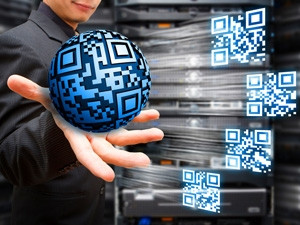
While the entry of quick response (QR) codes into the commercial arena a couple of years ago initially created some hype, interest in and use of the two-dimensional barcode technology has waned locally.
However, industry professionals say the QR code's days are far from numbered - with innovation and easier access having the ability to breathe new life into it.
One local businessman is using the relatively new technology - together with SA's huge uptake of smartphones - to take on real world needs in Soweto, where over 200 funerals and weddings can take place over a weekend.
Lebohang Khitsane, a funeral director who last month introduced a QR code system for funeral goers and bereaved families that addresses the problem of getting lost or attending the wrong service, used the same concept for a local wedding this weekend.
According to Khitsane, the funeral product has seen considerable uptake among families, as well as other funeral homes, and is being further developed beyond its current applications.
On a basic level, QR codes are barcodes that can be scanned using smartphones and tablets. An app that allows users to scan the code can be installed free of charge, if it is not pre-installed as it is on the BlackBerry platform. Once the QR code is scanned, it takes the user to a Web site URL, displays information or opens a contact card that can be saved.
End-user apathy
Tech analyst Liron Segev says the QR code, in a commercial context, has a vast amount of uses that will give end-users more value than simply opening a URL they could type into their browsers themselves anyway. "In SA, the QR code is just not used the same way it is overseas. In Europe, for example, people are fanatical about the technology - but that is because of the value-add it presents beyond just giving information."
Segev says the technology in itself is perfectly useable in SA, but a lack of innovation and how it is being used locally has resulted in poor uptake and a lack of interest. "There are no technology barriers, no geographical exclusions that prevent SA companies from expanding on the technology."
He cites a number of useful applications the technology is used for abroad that, if employed by local companies, could revive the QR code. "If a company like Computicket or Kulula had to come up with a really hot campaign, it would likely take off here."
In Europe, says Segev, QR code is used for concert tickets, to add details to smartphone users' calendars, on hotel brochures to add contact information to a phone, by food chains to allow the user to place an order, and on street signs to direct lost tourists by automatically dialling a number when scanned.
World Wide Worx MD Arthur Goldstuck says the fundamental barrier to entry among end-users is really the fact that a QR reader needs to be downloaded in most cases before the technology can be used.
"This is the real drawback. It is not so much about innovation as it is about complexity. Once you have the app it is pretty simple, but people are averse to having to go through an extra step. This is what reduces take up."
He says, when it comes to commercial apps in particular, people are put off by having to step further out of their comfort zone and sign up for another step in the process.
Goldstuck compares it to would-be online buyers, and the added verification mechanisms credit card companies are introducing. "[End-users] are looking for an excuse not to go through with an online transaction. The moment you add an extra step you are giving them the excuse not to. They want security, but they want invisible security."
Advanced application
Beyond the basic, QR codes are used in a more advanced state to combat fraud and authenticate products and documents - a use Pitney Bowes says makes QR code a mounting - rather than moribund - technology.
A Fortune 500 company and one of the first companies in the world to introduce the commercial bar code system (in 1968), Pitney Bowes recently developed an encryption-rich hardware- and software-based platform, pbSecure, which is intended to safeguard against the growing threat of sophisticated copycat fraudsters.
"A QR code is a matrix 2D barcode (a two-dimensional manner in which information can be represented in the form of a square barcode containing tiny square blocks) that can store more information than a linear barcode. A QR code can be read by an optical imaging device using Reed-Solomon error correction technology to interpret the image and extract the appropriate data from the patterns," says Leon van der Merwe, business development manager at Pitney Bowes SA.
"QR codes are used and developed by companies for brand protection, document authentication, product authentication and anti-fraud solutions by applying advanced encryption technologies to the binary string that forms the barcode."
Locally, he says, Pitney Bowes is working with government to come up with commercially viable solutions to combat fraudulent replication and tampering of educational documents and records using pbSecure cryptographic technology to place an encrypted QR code on the document.
This QR code contains the original data linked to an encrypted data string that - when decrypted - will verify the contents of the original document, the institution that issued it and whether the data and/ or the pbSecure code have been tampered with in any way. Advancement in this space with QR codes can also be applied to - among other things - combat fraud with brands, contracts, certificates, artwork and tickets."
Share